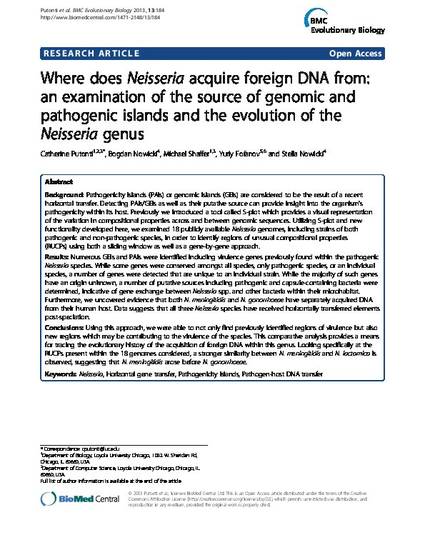
This journal is now called BMC Ecology and Evolution Background
Pathogenicity islands (PAIs) or genomic islands (GEIs) are considered to be the result of a recent horizontal transfer. Detecting PAIs/GEIs as well as their putative source can provide insight into the organism’s pathogenicity within its host. Previously we introduced a tool called S-plot which provides a visual representation of the variation in compositional properties across and between genomic sequences. Utilizing S-plot and new functionality developed here, we examined 18 publicly availableNeisseria genomes, including strains of both pathogenic and non-pathogenic species, in order to identify regions of unusual compositional properties (RUCPs) using both a sliding window as well as a gene-by-gene approach. Results
Numerous GEIs and PAIs were identified including virulence genes previously found within the pathogenic Neisseria species. While some genes were conserved amongst all species, only pathogenic species, or an individual species, a number of genes were detected that are unique to an individual strain. While the majority of such genes have an origin unknown, a number of putative sources including pathogenic and capsule-containing bacteria were determined, indicative of gene exchange between Neisseria spp. and other bacteria within their microhabitat. Furthermore, we uncovered evidence that both N. meningitidis and N. gonorrhoeae have separately acquired DNA from their human host. Data suggests that all three Neisseria species have received horizontally transferred elements post-speciation. Conclusions
Using this approach, we were able to not only find previously identified regions of virulence but also new regions which may be contributing to the virulence of the species. This comparative analysis provides a means for tracing the evolutionary history of the acquisition of foreign DNA within this genus. Looking specifically at the RUCPs present within the 18 genomes considered, a stronger similarity between N. meningitidis and N. lactamica is observed, suggesting that N. meningitidis arose before N. gonorrhoeae.
© The Author(s), 2013.

Author Posting. © The Author(s), 2013. This article is posted here by permission of the publisher BMC for personal use, not for redistribution. The article was published in BMC Evolutionary Biology, Volume 13, Issue 184, 2013, http://dx.doi.org/10.1186/1471-2148-13-184